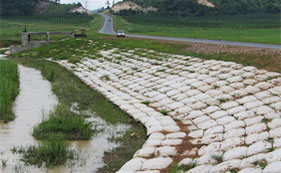
 Back to List
Back to List
The factors that determine the service life of the geomembrane anti-seepage membrane during the use process are divided into its own factors and environmental factors. Its own factors are the grade of raw materials, carbon black content, whether to add anti-ultraviolet anti-aging agent. Environmental factors are perennial contact with corrosive, other free substances with active chemical molecules, perennial sun exposure, etc.
Geomembrane impermeable membrane is a membrane made of polyethylene raw materials, in which the content of polyethylene is 97%, and the remaining 3% is divided into carbon black and anti-ultraviolet anti-aging agent. Some people think that the anti-ultraviolet and anti-aging agent added to the geomembrane impermeable membrane will not be damaged by the sun, but this is wrong. Although the anti-ultraviolet anti-aging agent can absorb sun rays and isolate some free substances, and protect the film body against thermal degradation and molecular chemical reaction, even after adding the anti-oxidation and anti-aging agent, the film body will be exposed to sunlight all the year round. Deformation and decomposition may occur, but if the anti-seepage membrane of geomembrane without anti-oxidation and anti-aging agent is used under exposure conditions, it will be oxidized and sun-damaged in a very short time. The changes in the life of the geomembrane impermeable membrane caused by environmental factors or natural aging factors can be judged by studying the changes in mechanical properties.



The reason why about 2% carbon black is added to the geomembrane impermeable membrane is to improve the performance degradation caused by natural aging. Theoretically, the performance of the film body can be extended for more than 50 years, and if the high-density polyethylene raw material is in an anaerobic state, the anti-ultraviolet effect is also very stable. During the reaction, only when the temperature is as high as 350°C or more, the molecular chain will be broken and decomposed into molecular fragments such as ethylene, propylene and butene. A famous Bell Lab in the United States once conducted experiments many years ago and concluded that the ability of polyethylene to resist ultraviolet rays and natural aging is more than 45 years.
Another special factor here is the proportion of anti-ultraviolet anti-aging agent and carbon black. The stability of the geomembrane will also be weakened, so when using the geomembrane anti-seepage membrane in special industries, it is necessary to use a high-density polyethylene membrane body with long-term reliability and stability. (density ≥ 0.91g/c㎡ is appropriate)